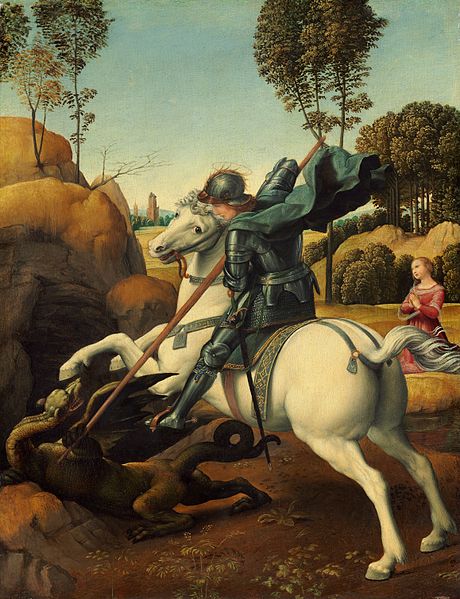Today is St George’s Day, the saint’s day of England’s patron saint and the purported day of Shakespeare’s birth (as well as being the day of his actual death in 1616. Ed.).
George was first adopted as England’s patron saint in the 14th century, when he was given the job and his predecessor St Edmund the Martyr, the 9th century king of East Anglia, was given the medieval equivalent of his P45. Nevertheless, traces of a cult of St George in England are discernible from the 9th century onwards in the form of a liturgy used at that time at Durham Cathedral, a 10th century Anglo-Saxon martyrology and in dedications to Saint George at Fordington in Dorset, Thetford in Norfolk, Southwark and Doncaster.
According to legend, George was a Roman soldier of Greek origin and officer in the guard of the Roman emperor Diocletian, who ordered his death for George failing to recant his Christian faith.
Looking at patronage, George is much more than the patron saint of England. Four other countries also have him as their patron saint, i.e.:
- Georgia;
- Malta;
- Portugal; and
- Romania.
Furthermore, George is also the patron saint of Spain’s autonomous communities of Aragon and Catalonia.
The best known feat about St George is his alleged dragon slaying. Just like his being a member of Diocletian’s guard, this is also legend. In the medieval romances, the lance with which Saint George is said to have slain the dragon was called Ascalon after the Levantine city of Ashkelon, which is in the modern state of Israel. As regards any factual basis for the legend, some evidence links the legend back to very old Egyptian and Phoenician sources in a late antique statue of Horus fighting a “dragon”. This links the legendary George – who should not be confused with the historical George – to various ancient sources of mythology around the eastern Mediterranean.

Speaking of dragons, the Old English Wordhord Twitter account came up with “ligdraca” – a fire-drake or dragon vomiting flames – for St George’s Day.

Celebrating St George’s Day has been more common in the past in England, although there have been times when it was celebrated less or not at all.
Indeed, Keith Flett informs us that its celebration was popular until the Reformation, but it was still marked. Under the Commonwealth, its celebration was banned in 1645 under the Long Parliament which sat from 1640 to 1660. When the English in their folly decided to invite Charles Stuart back in 1660 after the death of Cromwell, celebrating St George’s Day was restored.
Unlike St Andrew’s Day in Scotland, St George’s Day is not a public holiday (confusingly called a bank holiday in British English. Ed.). Indeed the countries of the United Kingdom have amongst the lowest numbers of public holidays in the developed world, whilst the UK as a whole has the the fewest of any G20 country or EU member state.
Whether to respond to this shortcoming or not, it’s been reported today that Labour leader Jeremy Corbyn will announce that Labour will introduce four new bank holidays – one for each of the patron saints of the countries making up the United Kingdom – if the party wins the forthcoming general election. This will be sold on the doorstep as a measure “to give workers the break they deserve“: and that’s definitely something for which I can vote.